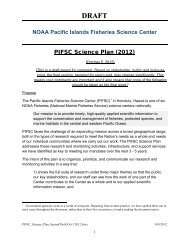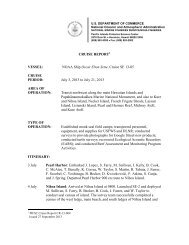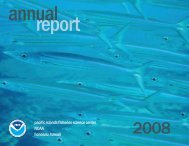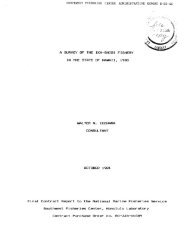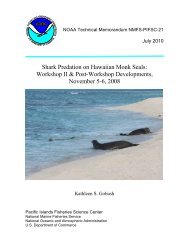Contingency Plan for Hawaiian Monk Seal Unusual Mortality Events
Contingency Plan for Hawaiian Monk Seal Unusual Mortality Events
Contingency Plan for Hawaiian Monk Seal Unusual Mortality Events
You also want an ePaper? Increase the reach of your titles
YUMPU automatically turns print PDFs into web optimized ePapers that Google loves.
2<br />
30N<br />
Kure Atoll<br />
Midway Atoll<br />
Pearl and Hermes Reef<br />
Lisianski I.<br />
Laysan I.<br />
25N<br />
French Frigate Shoals<br />
Necker I.<br />
Nihoa I.<br />
20N<br />
Northwestern <strong>Hawaiian</strong> Islands<br />
Main <strong>Hawaiian</strong> Islands<br />
Johnston Atoll<br />
15N<br />
180° 175W 170W 165W 160W 155W<br />
Fig. 1. The <strong>Hawaiian</strong> Archipelago, with the six main monk seal breeding and pupping<br />
sites identified (French Frigate Shoals, Laysan I., Lisianski I., Pearl and Hermes Reef,<br />
Midway Atoll, Kure Atoll).<br />
Females give birth on beaches with adjoining shallow waters, which provide<br />
protection from sharks. Most pups are born between February and August, with a peak<br />
from late March to May (Johnson and Johnson, 1980; Johanos et al., 1994). Females give<br />
birth <strong>for</strong> the first time at ages 5 to 10, and typically 50%-70% of all adult-size females<br />
give birth each year (Johanos et al., 1994). Gestation is approximately 1 year, with a<br />
mean interval between births (<strong>for</strong> those females that pup in consecutive years) of 381<br />
days (Johanos et al., 1994). Females fast during the 5 or 6-week nursing period, and<br />
nursing pups are sometimes exchanged between females (Kenyon and Rice, 1959; Alcorn<br />
and Henderson, 1984; Boness, 1990; Gerrodette et al., 1992). Mating occurs 3 or 4 weeks<br />
after pups are weaned. Although mating takes place in the water and is rarely observed, a<br />
mating peak in May and June is inferred from the occurrence of fresh mounting injuries<br />
and association patterns of males and females (Johanos et al., 1994). Unlike other<br />
gregarious pinnipeds, monk seals are typically solitary and do not <strong>for</strong>m large, seasonal<br />
breeding aggregations. They have a serially monogamous social system with males<br />
<strong>for</strong>ming a dominance hierarchy.<br />
Pups are born with a black coat, which is shed gradually at the end of the nursing<br />
period and replaced by pelage that is silver gray on the dorsum and sides and beige on the<br />
venter. Juveniles and adults undergo a “catastrophic” annual molt, in which the epidermis



